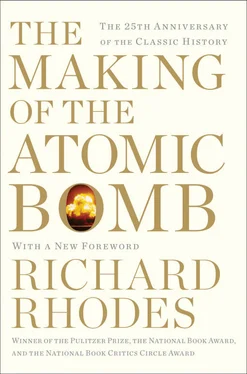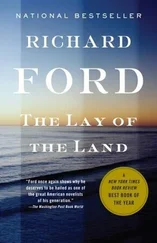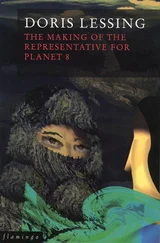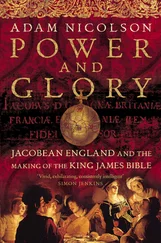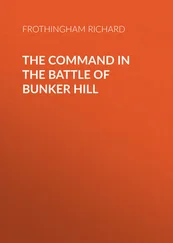By adding other carriers and precipitating other compounds D’Agostino proved that the thirteen-minute substance was neither protactinium (91), thorium (90), actinium (89), radium (88), bismuth (83) nor lead (82). Its behavior excluded elements 87 (then known as ekacesium), and 86 (radon). Element 85 was unknown. Perhaps because the half-lives were different, Fermi made no attempt to check polonium (84). But he felt he had been sufficiently thorough. “This negative evidence about the identity of the 13 min-activity from a large number of heavy elements,” he reported cautiously in Nature in June, “suggests the possibility that the atomic number of the element may be greater than 92.” 799
Corbino injudiciously announced “a new element” at the annual convocation, the King of Italy in attendance, that closed the academic year, which set the press baying and gave Fermi a few sleepless nights. 800Having so splendidly accomplished Szilard’s “rather boring task,” the weary physicist was happy to depart after that with his wife and their small daughter Nella for a summer lecture tour sponsored by the Italian government through Argentina, Uruguay and Brazil.
* * *
Leo Szilard had emerged from his bath that spring of 1934 to pursue his favorite causes, not yet joined, of releasing the energy of the nucleus and of saving the world. In a late-April memorandum condemning the recent Japanese occupation of Manchuria he seemed to look ahead to a far future: “The discoveries of scientists,” he wrote, “have given weapons to mankind which may destroy our present civilization if we do not succeed in avoiding further wars.” 801He probably meant military aircraft; the horrors of strategic bombing and even its potential for deterrence through a balance of terror were much bruited at mid-decade. But almost certainly he was also thinking of atomic bombs.
Several weeks earlier, looking for a patron, he had sent Sir Hugo Hirst, the founder of the British General Electric Company, a copy of the first chapter of The World Set Free. “Of course,” he wrote Sir Hugo with a touch of bitterness, still brooding on Rutherford’s prediction, “all this is moonshine, but I have reason to believe that in so far as the industrial applications of the present discoveries in physics are concerned, the forecast of the writers may prove to be more accurate than the forecast of the scientists. The physicists have conclusive arguments as to why we cannot create at present new sources of energy for industrial purposes; I am not so sure whether they do not miss the point.” 802
That Szilard saw beyond “energy for industrial purposes” to the possibility of weapons of war is evident in his next patent amendments, dated June 28 and July 4, 1934. Previously he had described “the transmutation of chemical elements”; now he added “the liberation of nuclear energy for power production and other purposes through nuclear transmutation.” He proposed for the first time “a chain reaction in which particles which carry no positive charge and the mass of which is approximately equal to the proton mass or a multiple thereof [i.e., neutrons] form the links of the chain.” 803He described the essential features of what came to be known as a “critical mass”—the volume of a chain-reacting substance necessary to make the chain reaction self-sustaining. 804He saw that the critical mass could be reduced by surrounding a sphere of chain-reacting substance with “some cheap heavy material, for instance lead,” that would reflect neutrons back into the sphere, the basic concept for what came to be known (by analogy with the mud tamped into drill holes to confine conventional explosives) as “tamper.” And he understood what would happen if he assembled a critical mass, spelling out the results simply on the fourth page of his application: 805
If the thickness is larger than the critical value… I can produce an explosion.
As if to mark in some distant inhuman ledger the end of one age and the beginning of another, Marie Sklodowska Curie, born in Warsaw, Poland, on November 7, 1867, died that day of Szilard’s filing, July 4, 1934, in Savoy. Einstein’s was the best eulogy: “Marie Curie is,” he said, “of all celebrated beings, the only one whom fame has not corrupted.” 806
There is nothing in the documentary record to indicate that Szilard was yet thinking of uranium. His June amendment describes a possible chain reaction using light, silvery beryllium, element number 4 on the periodic table.
To study that metal Szilard needed access to a laboratory and a source of radiation. The beryllium nucleus was so lightly bound he suspected he could knock neutrons out of it not only with alpha particles or neutrons but even with gamma rays or high-energy X rays. Radium emitted gamma rays and radium was available conveniently at the nearest large hospital. So Szilard, an unusually practical visionary, dropped in to see the director of the physics department at the medical college of St. Bartholomew’s Hospital. Couldn’t he use St. Bart’s radium, “which was not much in use in summertime,” for experiments? Something of value to medicine might emerge. 807The director thought he could if he teamed up with someone on the staff. “There was a very nice young Englishman, Mr. [T. A.] Chalmers, who was game, and so we teamed up and for the next two months we did experiments.”
Their first experiment demonstrated a brilliantly simple method for separating isotopes of iodine by bombarding an iodine compound with neutrons. They then used this Szilard-Chalmers effect (as it came to be called), which was extremely sensitive, as a tool for measuring the production of neutrons in their second experiment: knocking neutrons out of beryllium using the gamma radiation from radium. “These experiments,” Szilard reminisces wryly, “established me as a nuclear physicist, not in the eyes of Cambridge, but in the eyes of Oxford. [Szilard had in fact applied to Rutherford that spring to work at the Cavendish and Rutherford had turned him down.] I had never done work in nuclear physics before, but Oxford considered me an expert…. Cambridge… would never had made that mistake. For them I was just an upstart who might make all sorts of observations, but these observations could not be regarded as discoveries until they had been repeated at Cambridge and confirmed.” 808, 809
If Szilard’s summer work helped establish his Oxford reputation, it was also a personal disappointment: beryllium proved an unsatisfactory candidate for chain reaction. The problem, not settled until 1935, lay with the established mass of helium. 810The one stable isotope of beryllium consists of two helium nuclei lightly bound by a neutron. Its apparently high mass, which was calculated from Francis Aston’s measurements of the mass of helium, seemed to indicate that it should be unstable. But the mass spectrograph was a skittish instrument even in the hands of its inventor, and as Bethe, Rutherford and others were about to demonstrate, Aston’s measurements were inaccurate: he had set the mass of helium too high. One casualty of that error was beryllium’s candidacy for chain reaction, for nuclear power and atomic bombs.
* * *
Emilio Segrè and Edoardo Amaldi pilgrimaged to Cambridge early in July, short on English but carrying with them a comprehensive report on the Rome neutron-bombardment investigations. 811They met Chadwick, Kapitza and the other regulars at the Cavendish; observed the retired J. J. Thomson making his rounds; noted Aston, says Amaldi innocently, “going on improving the accuracy of his measurements of atomic masses”; and had a memorable meeting with Rutherford, whose “strong personality dominated the whole laboratory.”
The two young physicists had come to compare experiments with two of Rutherford’s boys. An unanswered question hung over the neutron work, a question that called existing nuclear theory into doubt. 812The Nature paper they brought with them discussed the difficulty frankly. It concerned what is called “radiative capture,” the typical reaction of the heavy elements to neutron bombardment: a nucleus captures a neutron, emits a photon of gamma radiation to stabilize itself energetically and thus becomes an isotope one mass unit heavier.
Читать дальше
